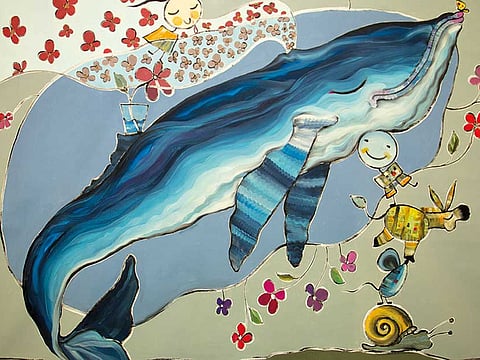Politics and urban planning
Ala Younis’s new body of work focuses exclusively on women, and looks beyond the male dominance of Baghdad’s politics and architecture

In 2015, Plan for Greater Baghdad, a research-based work created by Ala Younis was exhibited in the central exhibition of the 56th Venice Biennale. The work looked at the impact of changing political situations on government commissioned monuments and architectural plans in Iraq and on the architects and other people associated with them. The Jordan-based Kuwait-born artist, writer and curator, who has a degree in architecture told this story through the history of Baghdad’s only structure designed by renowned Swiss architect Le Corbusier. This is a gymnasium named after Saddam Hussain, which took over two decades to be built, and was completed after Corbusier’s death due to the many political changes in the country.
Younis researched archives, found material and the stories of the architects, artists, officials and other men involved in various stages of the project to create a timeline with inkjet prints and drawings highlighting the history of the building and significant moments and people related to it. The timeline also includes other important events such as various military coups, regime changes, wars, revolution and bombings that happened during the 25 years it took — from approval of Corbusier’s original design in 1958 to its completion with a modified design in the early 1980s.
Based on this timeline, she also created an installation featuring digitally sculpted and 3-D printed models of the gymnasium and of some of the men associated with it depicted in poses referencing key moments. Together, these works explore issues related to the protection of monuments for posterity, and the creation of plans for Baghdad either as an expression of power or a necessity.
Younis has now created another work, Plan (fem.) for Greater Baghdad, which focuses exclusively on women, and looks beyond the male dominance of Baghdad’s politics and architecture. This includes a detailed timeline based on archival documents, found materials and oral histories and a new installation commissioned by the Delfina Foundation and Art Jameel, showing the interior of the structure and telling the stories of the women who contributed significantly in the city’s development and history as artists, architects, civil engineers, writers, poets, social and political activists or supportive spouses.
The work was exhibited simultaneously at Delfina Foundation in London and Project Space Art Jameel in Dubai last month. In Dubai, the Barjeel Art Foundation has loaned the 2015 installation, which is in their collection, allowing for both works to be exhibited together for the first time in an exhibition titled, Plan for Feminist Greater Baghdad. Younis is also displaying a collection of her research materials which include photographs, books, diaries and films.
The women who inspired this research and feature prominently in the work include Balkis Sharara, wife of celebrated Iraqi architect Rifat Chadirji who in 1979 smuggled copies of his works into Abu Ghraib allowing him to write three of his seminal books while in prison; artist Nuha Al Radi whose diaries of 1990/91 offer unique insights into the struggles of daily life in Baghdad during the war; artist Fahrelnissa Zeid, wife of the Iraqi Ambassador in London, at the time when Le Corbusier received the telegram confirming the approval of his design proposal; poet Iman Mersal who paid a solidarity visit to Baghdad in 1993 while it was under siege and was given an audience by Saddam; and architect Zaha Hadid, whose work influenced the imagination of Iraqi architecture students in the 1990s.
“The title, Plan for Greater Baghdad, is taken from a proposal by John Lloyd Wright, which is like an unfulfilled promise. I was interested in studying how political changes affected urban planning and architecture, as well as the lives of the architects and others who got caught in the turmoil. I focused on Corbusier’s gymnasium because it reflects the aspirations of this region as well as the impact of political turmoil on those aspirations. Just two days after Corbusier’s design for a sports complex was approved, there was a coup in Iraq and the master plans for the city were revised by the new prime minister. This was followed by other changes in regimes and plans and finally, only the gymnasium was completed during Saddam Hussain’s presidency and hence is named after him. Saddam also invited other famous architects to build buildings and monuments in Baghdad which became strategic targets during the Gulf War, leaving the gymnasium as one of the few surviving designs by an iconic architect in the city. The building is like a heritage site carrying various cultural, social, political and historical narratives,” Younis says.
The artist emphasises that her new work is a feminine version but not a feminist one. “Although men had the power in politics and planning, I wanted to highlight that women made significant contributions in reviving the project, making the drawings, assisting the architects, and also in documenting the struggles of ordinary people and helping them when the city was under siege,” she says.
Plan for Feminist Greater Baghdad will run at Project Space Art Jameel, Alserkal Avenue, until April 14.
Sign up for the Daily Briefing
Get the latest news and updates straight to your inbox



